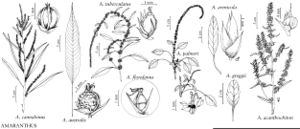Amaranthus floridanus
Madroño 13: 25. 1955.
Stems erect, branched, slender, usually (0.5–)1–1.5 m. Leaves: petiole 1/4 length of blade; blade linear to narrowly oblong, usually 10(–20) × 1 cm, base narrowly cuneate, margins entire, plane, apex obtuse to rounded. Inflorescences terminal, linear spikes to panicles. Bracts: of pistillate flowers 1–1.5 mm; of staminate flowers with moderately heavy midrib, 1–1.5 mm. Pistillate flowers: tepals 1–2(–3), unequal, inner tepals lanceolate to narrowly lanceolate, 1–1.5 mm, apex acute to acuminate; style branches spreading; stigmas 3. Staminate flowers: tepals 5, with excurrent midrib, equal to subequal, 2(–2.5) mm, apex acute to indistinctly mucronulate in outer tepals; stamens 5. Utricles reddish to reddish brown, occasionally with indistinct longitudinal ridges, subglobose to broadly obovoid, 1.5–2.5 mm, wall thin or slightly fleshy, irregularly rugose. Seeds dark reddish brown to dark brown, 0.7–1 mm diam., shiny.
Phenology: Flowering late spring–fall.
Habitat: Coastal dunes, beaches, swamps, marshes, disturbed habitats, such as gardens and fields near coast
Elevation: 0-10 m
Discussion
Selected References
None.
